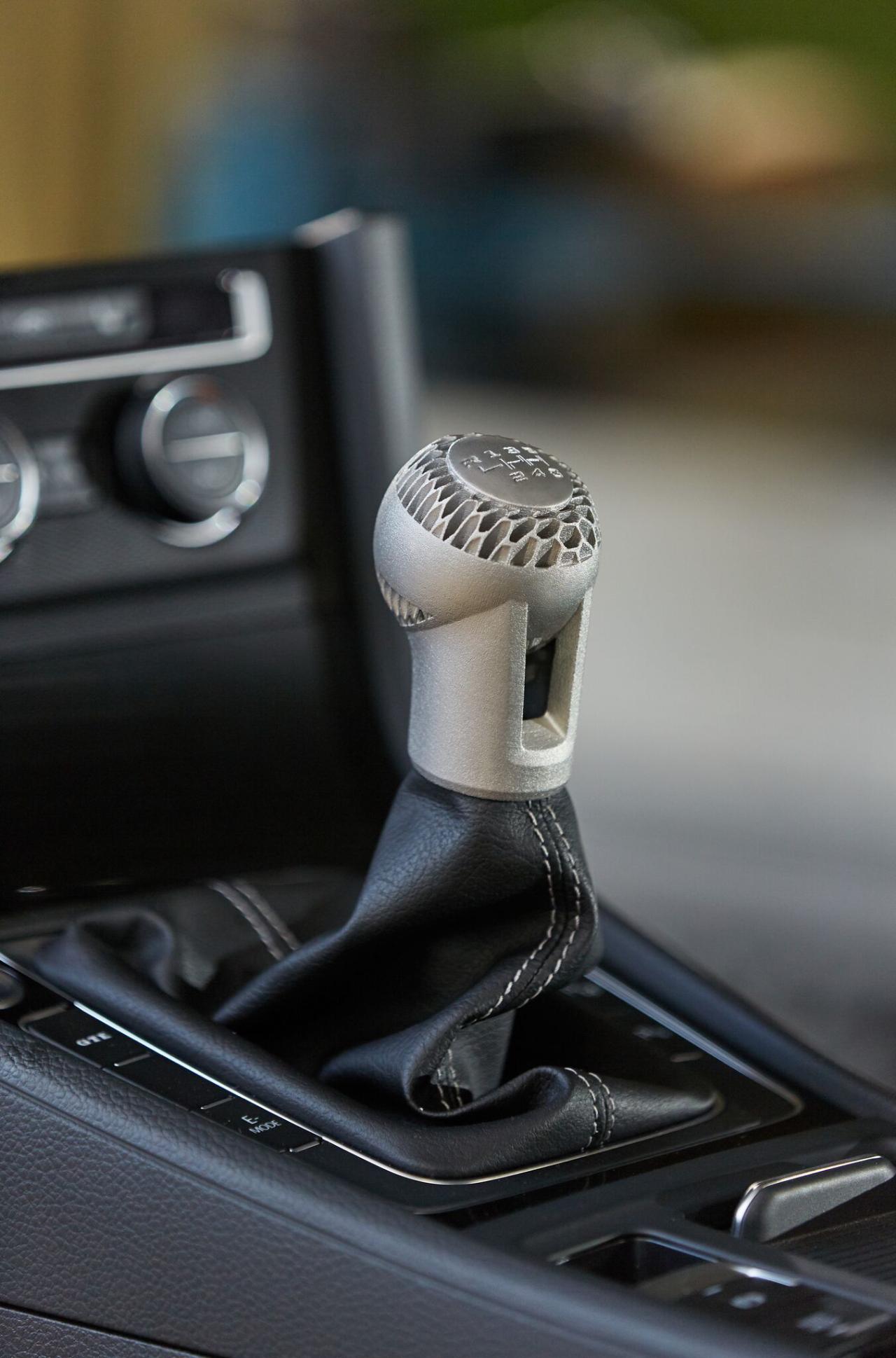Upon previously announcing itself as one of HP’s partners for MetalJet 3D printing, Volkswagen has revealed that it is now using the technology to make end parts at its primary production facility in Wolfsburg, Germany. According to the largest vehicle manufacturer (by sales), it is the only car maker using binder jetting in its production line.
In 2018, HP shook the 3D printing space with news of its metal binder jetting technology. Along with new entrant Desktop Metal, metal binder jetting was suddenly the new focus of attention with its ability to 3D print metal parts at a price much lower than powder bed fusion, the dominant metal additive manufacturing (AM) tech in the industry. By producing a green part that could be sintered in a furnace, MetalJet was ready to take advantage of existing infrastructure and know-how associated with the metal injection molding (MIM) sector and take the world by storm.

Two Volkswagen employees check the quality of structural parts produced using the binder jetting process for car production in front of the prototype of the special printer at the high-tech 3D printing center in Wolfsburg. Image courtesy of VW.
Since then, the rollout has not been entirely quick, but the customers using MetalJet have been substantial. For instance, Cobra Golf, a subsidiary of Puma, used it to 3D print a consumer putter in 2020. The United States Marine Corps is using HP’s binder jetting to 3D print replacement parts for amphibious vehicles. British multinational GKN is also running the machines in its 3D printing service bureau.
Volkswagen has invested “an amount in the mid-double-digit million euro range over the past five years” into 3D printing. It has 13 systems for metal and plastic 3D printing at its Wolfsburg plant. In plastic, it 3D prints prototypes for such items as center consoles, door cladding, bumpers and instrument panels. In metal, it 3D prints prototypes for radiators, intake manifolds, brackets and support pieces. In total, the company claims it has produce over a million components.
To build its binder jetting capabilities, the automaker is partnering with Siemens and expanding its work with HP. Siemens is providing VW with special software for AM, working with the company to optimize part positioning within the build chamber, thus making it possible to 3D print twice as many components in a single print job.

A 3D printed gearshift knob that VW revealed with the unveiling of MetalJet in 2018. Image courtesy of HP.
“We are very proud to support Volkswagen with our innovative 3D printing solutions. Our automation and software solutions are leading in industrial production applications. Using this technology, Volkswagen will be able to develop and produce components faster, more flexibly and using fewer resources,” said Cedrik Neike, member of the Managing Board of Siemens AG and CEO Digital Industries.
As the three companies create a “joint expert team” at the 3D printing center opened at Wolfsburg in 2018, they will push the technology toward full-scale production of parts. This includes developing the experience to determine which components can be 3D printed in a fast and affordable fashion.
It wasn’t until the introduction of binder jetting that metal 3D printing was deemed cost-effective for Volkswagen. Now, the conglomerate aims to 3D print 100,000 vehicle parts annually by 2025. The first items made with binder jetting are for the A pillar in the upcoming T-Roc convertible, which are currently being certified at the company’s site in Osnabrück. Volkswagen says that these parts weigh 50 percent less than traditionally made sheet steel counterparts. The company has already performed crash tests on 3D printed metal vehicle parts, though they did not specify if these A pillar elements in particular were those tested.
If all goes as planned, this will be a huge deal for 3D printing and the automotive space. Manufacturers have so far only toyed around with the use of 3D printed end parts in luxury, sports and race vehicles, but not yet in a consumer-oriented car. This would then be the first mass produced auto with 3D printed components, meaning that an average person could encounter a 3D printed element out in the wild. Just as everything Airbus is doing for the A350 is significantly boosting the role and visibility of AM in aerospace, VW will be doing the same for the automotive industry. 3D printing in automotive is predicted to result in a $9 billion opportunity by 2029, according to SmarTech Analysis, and Volkswagen would be leading the pack.
Where just a few years ago, VW was the brand most associated with the car emissions scandal (overlooking Volvo, Renault, Jeep, Hyundai, Citroën and Fiat, who also cheated their diesel emissions testing), this could help polish the conglomerate’s previously tarnished past. If Volkswagen can implement 3D printing across its companies, it could ultimately reduce the weight of its vehicles, thus cutting emissions for gas cars and improving electricity range for its EVs. It won’t be enough to save the planet, but it would be enough to save VW.
Subscribe to Our Email Newsletter
Stay up-to-date on all the latest news from the 3D printing industry and receive information and offers from third party vendors.
You May Also Like
Profiling a Construction 3D Printing Pioneer: US Army Corps of Engineers’ Megan Kreiger
The world of construction 3D printing is still so new that the true experts can probably be counted on two hands. Among them is Megan Kreiger, Portfolio Manager of Additive...
US Army Corps of Engineers Taps Lincoln Electric & Eaton for Largest 3D Printed US Civil Works Part
The Soo Locks sit on the US-Canadian border, enabling maritime travel between Lake Superior and Lake Huron, from which ships can reach the rest of the Great Lakes. Crafts carrying...
Construction 3D Printing CEO Reflects on Being Female in Construction
Natalie Wadley, CEO of ChangeMaker3D, could hear the words of her daughter sitting next to her resounding in her head. “Mum, MUM, you’ve won!” Wadley had just won the prestigious...
1Print to Commercialize 3D Printed Coastal Resilience Solutions
1Print, a company that specializes in deploying additive construction (AC) for infrastructure projects, has entered an agreement with the University of Miami (UM) to accelerate commercialization of the SEAHIVE shoreline...






























